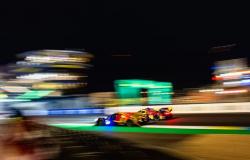Ferrari has officially announced the successor to the LaFerrari with the introduction of the F80 hypercar, a stunning blend of hybrid technology and cutting-edge design. Scheduled to hit the market in late 2025, this $4 million beast is set to redefine the hypercar landscape, pushing the boundaries of speed, power and performance.
Driveline Innovation: A New Era for Ferrari
At the heart of the F80 is a revolutionary V-6 hybrid engine, marking a departure from Ferrari’s iconic V-12s. This 3.0-liter turbo V-6, paired with three electric motors, generates an incredible 1,184 horsepower, making the F80 the most powerful Ferrari ever built. The gasoline engine alone develops 900 hp, and when combined with the electric motors, the F80 can go from 0 to 100 km/h in just 2.15 seconds and reach a top speed of 350 km/h .
This hybrid system is derived from Ferrari’s work with the 296 sports car and the 499P Le Mans race car, but with significant improvements. With modified ignition, adjusted injection timing and increased combustion pressure, the F80’s V-6 reaches a top speed of 9,000 rpm. Electric turbos further reduce response time, and the eight-speed dual-clutch transmission is calibrated to handle the extra power.
Aerodynamics and Design: Inspiration from Formula 1
The F80’s sleek, aggressive design comes directly from Ferrari’s expertise in Formula 1. With a pointed nose, signature S-Duct and active aerodynamics, the car generates more than 2,200 pounds of downforce at 155 mph. The front end alone produces 1,014 pounds of downforce, while an active rear wing and huge diffuser manage airflow out back.
Flavio Manzoni of the Ferrari Styling Center designed the F80, incorporating retro elements like F40-inspired rear wheel arches and a Daytona-style headlight sunshade. The carbon fiber monocoque chassis is asymmetrical, offering an adjustable driver’s seat, while fixed gullwing doors complete the hypercar’s striking look.
Advanced Hybrid System and Driving Modes
Ferrari engineers developed the electric motors in-house, with two mounted on the front axle for torque vectoring and regenerative braking, while a third assists the rear wheels. This configuration, linked to an 800-volt battery pack, produces an additional 325 hp and allows energy recovery during braking.
The F80 offers three driving modes: Hybrid, Performance and Qualifier. Hybrid mode prioritizes efficiency and energy recovery, while Performance mode balances power and battery charge. For maximum power, Qualifier mode unleashes the car’s full 1,184 hp, making it track-ready for hypercar enthusiasts.
Unparalleled Handling and Braking
To ensure premium handling, Ferrari has partnered with Brembo to create new CCM-R Plus carbon brakes, which feature 100% stronger mechanical integrity and improved thermal connectivity compared to traditional carbon brakes. The F80 also features an advanced active suspension system, helping to optimize ride quality and high-lift stability.
Michelin Pilot Sport Cup 2 tires are standard, ensuring the car has optimal grip on the road, while Ferrari has integrated active safety features such as automatic emergency braking, lane departure warning and traffic sign recognition, a first for a hypercar of this caliber.
The most expensive Ferrari in history
With only 799 units planned, the Ferrari F80 is priced at 3.6 million Euros (approximately $4 million USD), making it the most expensive new Ferrari in history. Production will run from 2025 to 2027, with each model representing the pinnacle of Ferrari’s technical know-how.
As Ferrari steps into the future with the F80, the brand aims to not only honor its past, but also set a new benchmark for the entire hypercar industry. With breathtaking power, cutting-edge hybrid technology and a price to match, the F80 is poised to become a legend in the making.





